
A mushroom or toadstool is the fleshy, spore-bearing fruiting body of a fungus, typically produced above ground, on soil, or on its food source. Toadstool generally denotes one poisonous to humans.

Agaricus bisporus, commonly known as the cultivated mushroom, is a basidiomycete mushroom native to grasslands in Eurasia and North America. It is cultivated in more than 70 countries and is one of the most commonly and widely consumed mushrooms in the world. It has two color states while immature – white and brown – both of which have various names, with additional names for the mature state, such as chestnut, portobello, portabellini, button and champignon de Paris.

Agaricus xanthodermus, commonly known as the yellow-staining agaricus, yellow-staining mushroom or yellow-stainer, is a mushroom of the genus Agaricus, which displays a strong yellow colouration at the base of the stem when cut. It has a phenolic smell. It is poisonous for most people, causing gastrointestinal upset, but can be eaten by some without apparent negative effect.

Agaricus is a genus of mushroom-forming fungi containing both edible and poisonous species, with over 400 members worldwide and possibly again as many disputed or newly-discovered species. The genus includes the common ("button") mushroom and the field mushroom, the dominant cultivated mushrooms of the West.

Agaricus subrufescens is a species of mushroom, commonly known as almond mushroom, almond agaricus, mushroom of the sun, God's mushroom, mushroom of life, royal sun agaricus, jisongrong, or himematsutake. A. subrufescens is edible, with a somewhat sweet taste and a fragrance of almonds.

In mycology, a partial veil is a temporary structure of tissue found on the fruiting bodies of some basidiomycete fungi, typically agarics. Its role is to isolate and protect the developing spore-producing surface, represented by gills or tubes, found on the lower surface of the cap. A partial veil, in contrast to a universal veil, extends from the stem surface to the cap edge. The partial veil later disintegrates, once the fruiting body has matured and the spores are ready for dispersal. It might then give rise to a stem ring, or fragments attached to the stem or cap edge. In some mushrooms, both a partial veil and a universal veil may be present.
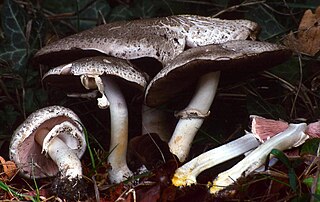
Agaricus moelleri, commonly known as the flat-top agaricus, inky mushroom, or dark scaled mushroom, is a large mushroom of the genus Agaricus. It appears occasionally in most kinds of woodland, during late summer, in northern temperate zones.
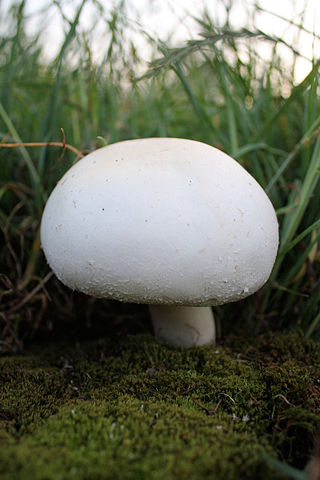
Agaricus arvensis, commonly known as the horse mushroom, is a mushroom-forming fungus of the genus Agaricus.
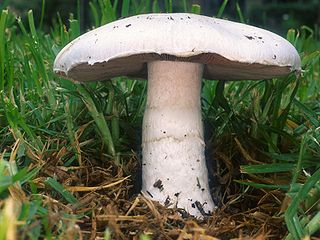
Agaricus campestris is a widely eaten gilled mushroom closely related to the cultivated A. bisporus. A. campestris is commonly known as the field mushroom or, in North America, meadow mushroom.
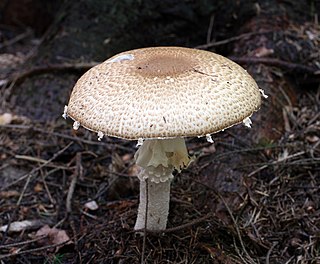
Agaricus augustus, known commonly as the prince, is a basidiomycete fungus of the genus Agaricus.
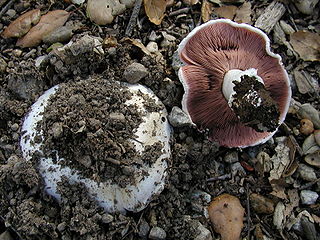
Agaricus bitorquis, commonly known as torq, banded agaric, spring agaric, banded agaricus, urban agaricus, or pavement mushroom, is an edible white mushroom of the genus Agaricus, similar to the common button mushroom that is sold commercially. The name supersedes Agaricus rodmani.
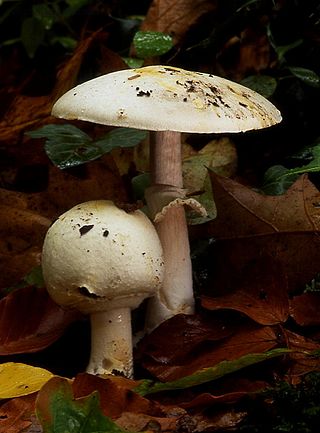
Agaricus silvicola, also known as the wood mushroom or woodland agaricus, is a species of Agaricus mushroom related to the button mushroom. A. silvicola is a member of Agaricus section Arvenses, a group of morphologically similar mushrooms. A. silvicola, like other species in Agaricus section Arvenses, exhibits a positive Schäffer's reaction and potassium hydroxide reaction, and smells of almonds or anise.
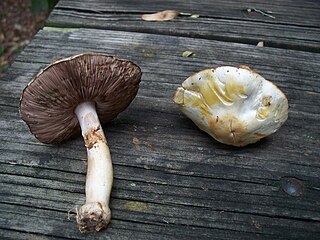
Agaricus abruptibulbus is a species of mushroom in the genus Agaricus. It is commonly known as the abruptly-bulbous agaricus or the flat-bulb mushroom. First described by the mycologist Charles Horton Peck, this bulbous-stemmed edible species smells slightly of anise or bitter almond, and turns yellow when bruised or cut. The mushroom is medium-sized, with a white, yellow-staining cap on a slender stipe that has a wide, flat bulb on the base.

Agaricus silvaticus, otherwise known as the scaly wood mushroom, blushing wood mushroom, or pinewood mushroom, is a species of mushroom often found in groups in coniferous forests from early summer, or September through to November in Europe, North Africa and North America.

Lepiota clypeolaria, commonly known as the shield dapperling or the shaggy-stalked Lepiota, is a common mushroom in the genus Lepiota. It is widely distributed in northern temperate zones, where it grows in deciduous and coniferous forest. Fruit bodies have a brownish cap, a shaggy stipe with a collapsed, sheathing ring or ring zone, and spindle-shaped spores.

Agaricus hondensis, commonly known as the felt-ringed agaricus, is a species of fungus in the family Agaricaceae. The species was officially described in 1912 by mycologist William Alphonso Murrill, along with three other Agaricus species that have since been placed in synonymy with A. hondensis. Found in the Pacific Northwest region of North America, A. hondensis fruits in the fall under conifers or in mixed forests.
Julius Schäffer was a German mycologist. His contributions include studies on the Agaricales, especially the genus Russula, about which he wrote a monograph in 1933. Later, he revised the genus in the series Die Pilze Mitteleuropas (1926–1967); his notes were published posthumously by his wife Liesel in 1952 with the help of other mycologists. The work was considered the "authoritative treatment of the group for Central Europe". One of the Russula species that was first described in this publication was R. laeta. Schäffer developed a chemical test to help with the identification of Agaricus species. A positive reaction of Schaeffer's test, which uses the reaction of aniline and nitric acid on the surface of the mushroom, is indicated by an orange to red color; it is characteristic of species in the section Flavescentes. The compounds responsible for the reaction were named schaefferal A and B to honor Schäffer.

Cortinarius camphoratus, commonly known as the goatcheese webcap, is an agaric fungus in the family Cortinariaceae. The fungus is found in Europe and North America, where its fruit bodies (mushrooms) grow on the ground in a mycorrhizal association with spruce and firs in coniferous forests. Mushrooms are characterized by pale blue lilac colors when young, and a strong distinctive odor. Sources disagree as to the edibility of the mushroom, but they are generally not recommended for eating.

Inosperma bongardii is an agaric fungus in the family Inocybaceae. It was originally described as a species of Agaricus by German botanist Johann Anton Weinmann in 1836. Lucien Quélet transferred it to the genus Inocybe in 1872. A 2019 multigene phylogenetic study by Matheny and colleagues found that I. bongardii and its relatives in the subgenus Inosperma were only distantly related to the other members of the genus Inocybe. Inosperma was raised to genus rank and the species became Inosperma bongardii.

Stropharia caerulea, commonly known as the blue roundhead, is a species of mushroom forming fungus in the family Strophariaceae. It is a somewhat common species found in Europe and North America, where it grows as a saprophyte in meadows, roadsides, hedgerows, gardens, and woodchip mulch. S. caerulea was officially described to science in 1979, although it was known to be a distinct species for about two centuries before that. The scientific name Stropharia cyanea, as defined by Tuomikoski in 1953, and used by several later authors, is a synonym of S. caerulea.



















